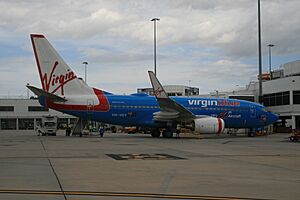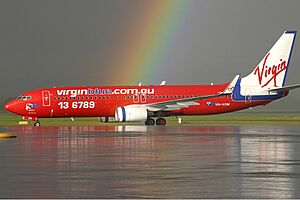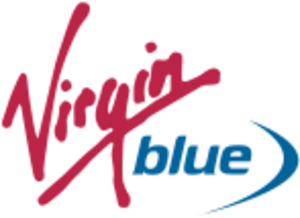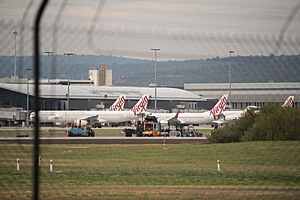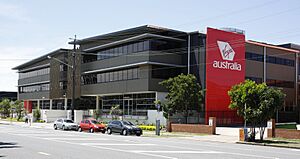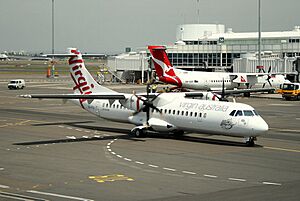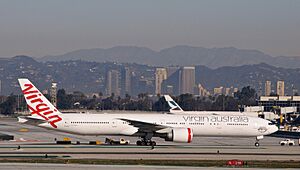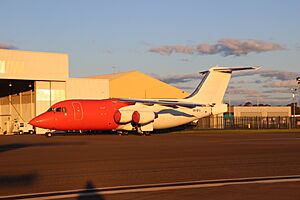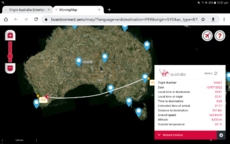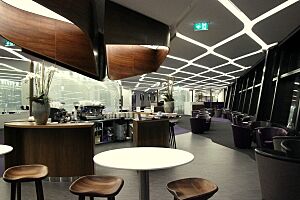Virgin Australia facts for kids

A Virgin Australia Boeing 737 MAX 8
|
|
| Founded | 29 August 2000 (as Virgin Blue) |
|---|---|
| Commenced operations | 4 May 2011 (as Virgin Australia) |
| AOC # | CASA.AOC.0010 |
| Hubs | |
| Secondary hubs |
|
| Focus cities |
|
| Frequent-flyer program | Velocity |
| Fleet size | 96 |
| Destinations | 40 |
| Parent company | Virgin Australia Holdings |
| Headquarters | South Bank, Queensland, Australia |
| Key people | |
| Revenue | |
| Operating income | |
| Total assets | |
| Total equity | |
Virgin Australia, once known as Virgin Blue, is a major Australian airline. It is based in Brisbane, Queensland. This airline is one of only two active airlines that use the famous Virgin brand. It also has the largest fleet of aircraft among them.
Virgin Australia started flying on August 31, 2000. It began with just two planes and one route. After another airline, Ansett Australia, stopped flying in September 2001, Virgin Blue quickly grew. It became a very important airline in Australia.
The airline uses a mix of business ideas. It offers both low-cost flights and full-service options. This means it tries to keep prices affordable while still offering good services. As of December 2024, it was Australia’s largest domestic airline. It carries the most passengers within Australia.
As of June 2025, Virgin Australia flies to 33 places across Australia. It uses Boeing 737 planes for these flights. Its main bases, called hubs, are in Brisbane, Melbourne, and Sydney. It also has smaller hubs in Adelaide and Perth.
The airline also flies a few short international routes. Australian law usually stops airlines mostly owned by foreign companies from flying international routes to and from Australia. However, Virgin Australia uses a special business setup to operate these flights. This setup is allowed by law.
The main office for Virgin Australia is in South Bank, Queensland. The airline was started by British businessman Richard Branson. He is the founder of the Virgin Group. Brett Godfrey, a former CEO, also helped start the airline.
In 2011, the airline changed its name to Virgin Australia. This change included new paint on its planes and new uniforms for staff. It also added new food choices and a business class section. Virgin Blue did not have a business class before. New, larger planes were bought to compete with Qantas. Business class was then added across all Virgin Australia flights.
On April 21, 2020, Virgin Australia Holdings faced big financial problems. This was due to the COVID-19 pandemic and money troubles from earlier years. The company went into a special legal process called administration. On June 26, 2020, it was announced that Bain Capital would buy Virgin Australia. The deal was completed on November 17, 2020. The airline then announced it would focus on being a "hybrid" airline. This means it would offer a mix of services for different types of travelers.
Contents
Airline's Journey: A Look Back
Starting as Virgin Blue (2000–2006)
Virgin Australia began as Virgin Blue in August 2000. It was a low-cost airline, meaning it offered cheaper flights by cutting some services. It started with two Boeing 737-400 planes. One of these planes was rented from its sister airline, Virgin Express.
At first, Virgin Blue offered seven flights a day between Brisbane and Sydney. Soon, it expanded to all major Australian cities and many holiday spots. The name "Virgin Blue" came from a public contest. It was a fun way to describe the airline's red planes. It also used Australian slang for a red-headed person, "Blue" or "Bluey."
Virgin Blue started at a good time in Australia. When Ansett Australia stopped flying in September 2001, Virgin Blue quickly filled the gap. This helped Virgin grow fast. It became Australia's second main domestic airline. It also got access to airport spaces that helped it expand.
As the airline grew, it got newer planes. It replaced its older 737-400s with more modern 737-700 and −800 series aircraft. These new planes had better technology and used less fuel.
Over time, the Virgin Group owned less of Virgin Australia. They sold part of it to an Australian company, Patrick Corporation. Later, some shares were sold to the public. By 2005, Patrick owned 62% of the company. The Virgin Group kept a 25% share.
In 2006, another company, Toll Holdings, bought Patrick. This made Toll the main owner of Virgin Blue. By 2013, Air New Zealand owned 23% of the company.
Virgin Blue used to follow a simple plan. It cut costs by not offering free meals or paper tickets. Instead, it sold food on board and used phone and internet booking. It also saved money by flying to fewer airports and using only one type of plane, the Boeing 737.
This plan changed when it added a second type of plane. The airline ordered 20 Embraer E-jets. These planes were for flying to smaller cities and to restart flights between Sydney and Canberra. The first Embraer E170 arrived in Australia in September 2007. Flights to Canberra and other regional centers began in February 2008. This helped Virgin compete more directly with Qantas.
Working with Other Airlines (2006–2010)
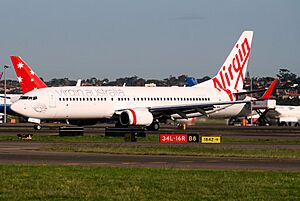
When Virgin Blue started in 2000, it did not work with other airlines. This changed after Ansett Australia stopped flying. Virgin Blue then started a codeshare agreement with United Airlines. This allowed United passengers to connect to Virgin Blue flights in Australia.
In 2006, Virgin Blue began making deals with other airlines to compete with Qantas. It made frequent flyer agreements with Emirates, Hawaiian Airlines, and Malaysia Airlines. It also worked with Regional Express Airlines for flights to smaller towns.
In November 2007, Virgin Blue announced a deal with Garuda Indonesia. This allowed passengers to connect to international Garuda flights. A similar deal was later made with Vietnam Airlines.

In 2008, Business class was added to all its planes. New seats were put in the first three rows. These seats could change from three economy seats to two larger premium seats. Business class offered faster check-in, more baggage allowance, and access to airport lounges. It also included more legroom, entertainment, meals, and drinks. This service was for business travelers.
In December 2010, Virgin Blue made agreements with Etihad Airways and Air New Zealand. These deals included sharing flights and lounge access. Virgin Blue also talked with Delta Air Lines about joining SkyTeam. SkyTeam is one of the world's largest airline groups. This agreement was approved in June 2011.
In January 2011, Air New Zealand announced it would buy a share in Virgin Blue. Air New Zealand said this was to grow its presence in the region.
Starting V Australia (2008–2011)
In early 2006, Virgin Blue said it wanted to fly to the U.S. It planned up to seven flights a week to Los Angeles or San Francisco. At that time, only Qantas and United Airlines flew between Australia and the U.S.
Australian regulators gave permission for ten flights a week in July 2007. U.S. regulators approved the plans in February 2008. Instead of using the Virgin Blue name, the airline started a new company called V Australia. This new airline had five 777-300ERs with their own special look.
V Australia started flights between Sydney and Los Angeles in 2009. It later added flights from Melbourne and Brisbane. V Australia also flew to Nadi International Airport (Fiji), Phuket (Thailand), and Johannesburg (South Africa). These flights were stopped before V Australia became part of Virgin Australia. It also flew to Abu Dhabi to work with Etihad Airways.
Becoming Virgin Australia (2011–2019)

On May 7, 2010, Brett Godfrey stepped down as Virgin Blue CEO. John Borghetti, a former Qantas manager, became the new CEO. After he arrived, many Qantas staff moved to Virgin Blue. This led to talk about the airline changing its brand.
In February 2011, the re-brand was confirmed. The airline announced it would drop "Blue" from its name. This was to attract more business travelers away from Qantas. New uniforms and business-class seats were also shown. The airline said the change would happen in steps. It would include a new look for planes and renaming other Virgin Blue Group airlines.
On May 4, 2011, the former Virgin Blue showed its new name, Virgin Australia. It also revealed its new plane design. Along with the new name and look, the airline showed its new main plane, the Airbus A330. This plane had a new domestic business class. Boeing 737 business class seats were also shown. These were added to all Virgin's jet planes by the end of 2011.
Pacific Blue and V Australia both became part of the new Virgin Australia brand. This happened after an agreement with Virgin Atlantic's former shareholder, Singapore Airlines. This agreement allowed the "Virgin" brand to be used outside Australia.
In 2011, Virgin Blue signed a ten-year deal with Skywest Airlines. Skywest would fly up to 18 ATR-72 turboprop planes for Virgin. This helped Virgin compete better in regional areas. These turboprops would replace the Embraer E170s, which were not as cost-effective.
In October 2011, the Australian Competition & Consumer Commission (ACCC) approved a codeshare deal between Singapore Airlines and Virgin Australia.
On May 31, 2016, a Chinese aviation company, HNA Group, agreed to buy 13% of Virgin Australia Holdings. This deal also created a codeshare partnership. It allowed Virgin Australia to work with Chinese airlines on flights between Australia and China. Virgin planned to start flights to Beijing and Hong Kong by 2017.
By October 2016, Air New Zealand sold its remaining shares in Virgin Australia. On April 4, 2018, Air New Zealand announced it would end its partnership with Virgin Australia. This change took effect on October 28, 2018.
On June 12, 2018, Virgin Australia CEO John Borghetti said he would leave the airline. He had been CEO since May 2010. In February 2019, Paul Scurrah was announced as the new CEO. He started on March 25, 2019.
On July 2, 2018, Virgin Australia started flights from Sydney to Hong Kong. This service stopped on March 2, 2020, due to the COVID-19 pandemic.
COVID-19 and Administration (2020)
On March 18, 2020, Virgin Australia CEO Paul Scurrah announced that 53 planes would be grounded. This was due to the COVID-19 pandemic. This meant Virgin Australia would temporarily become a domestic-only airline again.
On March 31, 2020, Virgin Australia asked the Australian Government for a $1.4 billion loan. This was to help it survive the COVID-19 crisis. Qantas, another airline, said if Virgin got a bailout, they should get a larger loan.
On April 4, 2020, the Australian Government said it would help pay for a small international network. Qantas and Virgin Australia would operate this for four weeks. Virgin started flying twice a week to Hong Kong and once a week to Los Angeles. On the same day, Virgin Australia decided to close its New Zealand operations. This meant 600 jobs were lost in New Zealand.
On April 9, 2020, almost all Virgin Australia flights were suspended from April 10. Only one return flight between Melbourne and Sydney flew six times a week.
On April 21, 2020, Virgin Australia confirmed it had gone into voluntary administration. This meant it could not continue without government help. However, flights that were still operating continued as planned.
Changes and Recovery (2020–2025)
In June 2020, Bain Capital bought Virgin Australia Holdings.
In August 2020, Bain Capital announced a plan for a new "Virgin Australia 2.0." This plan focused on making the airline simpler and more focused. It included stopping the use of ATR, Airbus A330, and 777 planes. The Tigerair brand was also stopped.
On October 15, 2020, Virgin Australia CEO Paul Scurrah announced he would resign. Jayne Hrdlicka was named his replacement. She started as CEO on November 18, 2020.
On December 15, 2021, Virgin Australia and United Airlines announced a new partnership. This started in April 2022. It ended the partnership with Delta Air Lines after more than ten years.
In September 2023, it was reported that some Virgin Australia planes had problems. Two Boeing 737-800s were temporarily taken out of service. Their engines had parts that were not approved.
On October 10, 2023, Virgin Australia announced it had made a profit for the first time in 11 years. It reported a profit of $129 million. Its income more than doubled to $5 billion. This showed the company was recovering well after COVID-19.
On May 1, 2024, the Australian Competition & Consumer Commission (ACCC) supported a new codeshare agreement. This was between Air New Zealand and Virgin Australia. It was formally approved in June 2024. This agreement covers specific routes to Auckland, Wellington, and Christchurch.
In October 2024, Qatar Airways agreed to buy a 25% share in Virgin Australia. This deal was approved in February 2025.
In February 2024, Jayne Hrdlicka said she would resign as CEO. In March 2025, Virgin Australia announced that Dave Emerson would become the new CEO. He was previously the Chief Commercial Officer.
Returning to the Stock Market (2025–Present)
To prepare for returning to the stock market, Peter Warne was named Chairman. He replaced Ryan Cotton. The company was relisted on the Australian Securities Exchange (ASX) in June 2025. Bain Capital reduced its ownership to 40%, and Qatar Airways now owns 23%.
How the Airline Works
Main Office
Until September 2020, Virgin Australia's main office was called Virgin Village. It was in Bowen Hills, Brisbane. This building had about 13,220 square meters (142,300 sq ft) of office space.
When the airline started, it chose Brisbane for its main office. Brett Godfrey, a co-founder, said this decision worked well. The airline bought a $61 million site in Bowen Hills for its new office. The new Virgin Village officially opened on October 17, 2008. In 2008, 1,000 employees worked there.
Sister Airlines
Past Sister Airlines
Pacific Blue
In September 2003, Pacific Blue was created. It offered low-cost flights between New Zealand and Australia. Pacific Blue wanted to compete with Air New Zealand and Qantas. Pacific Blue also flew for Polynesian Blue, a joint company with the government of Samoa. Pacific Blue has since been renamed and is now part of Virgin Australia.
V Australia
In early 2006, Virgin Blue's parent company wanted to fly to the United States. They planned up to seven flights a week to Los Angeles International Airport or San Francisco International Airport. On July 25, 2007, it was announced that "V Australia" would be the name of this new airline.
Tigerair Australia
On October 30, 2012, Virgin Australia Holdings bought 60% of Tiger Airways Australia. This cost $35 million. Tigerair was meant to be a low-cost airline for 20 years. In October 2014, Virgin took full control of Tigerair for one dollar. After Bain Capital bought Virgin Australia in 2020, Tigerair was stopped and then officially closed.
Current Sister Airline

Virgin Australia Regional Airlines
On April 11, 2013, Virgin Australia Holdings bought Skywest Airlines. Skywest was a regional airline. It was then renamed Virgin Australia Regional Airlines.
Marketing and Sponsorship
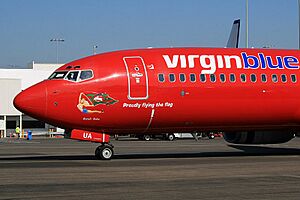
Since it started, Virgin Blue has sponsored many sports teams. This helps promote its brand. In February 2007, Virgin Blue signed a deal with the NRL team, the South Sydney Rabbitohs. One of the airline's Boeing 737-800s had a special design for this sponsorship. Virgin Australia is also a sponsor of the National Basketball League (NBL). It is also the main sponsor of the Brisbane Bullets NBL team.
In November 2010, the Australian Football League (AFL) chose Virgin Blue for a marketing deal. This deal was worth between A$5 million and A$8 million.
Virgin Blue also earned money and got attention by painting two planes as "flying billboards." One promoted a men's razor brand. The other promoted a Queensland Government campaign. Both planes are no longer part of the Virgin Blue fleet.
In 2007, Virgin Blue started an advertising campaign called "Get What You Want." In 2009, it launched a new campaign called "Now there's an idea." TV ads showed how flying in Australia changed from 1999 to 2009.
In 2011, when the airline became Virgin Australia, its slogan changed to "Now you're flying."
Virgin Australia became a sponsor of new AFL clubs. These included the Gold Coast Suns in 2011 and the Greater Western Sydney Giants in 2014. Virgin Australia also sponsors the Carlton Football Club. In 2016, the airline made a deal with V8 Supercars. The annual motorsport series was renamed the Virgin Australia Supercars Championship.
Awards
The airline has won many awards since it began. It and its employees won five service excellence awards in 2009. Since being named best low-cost airline in the Asia/Pacific region in 2002, it has won many awards.
As an employer, Virgin Australia was named the most attractive employer in Australia in 2015. Its frequent flyer program, Velocity Rewards, won many awards in 2009. These included best frequent flyer program and best website. Velocity Frequent Flyer also won awards in 2018. These included program of the year and best customer service.
Where Virgin Australia Flies
On December 11, 2024, Qatar Airways announced that passengers could book direct flights to Doha. These flights would be from Sydney, Brisbane, and Perth starting in June 2025. Melbourne will also be added later in 2025.
As of July 2025, Virgin Australia shares flights with these airlines:
- Air Canada
- Air India
- Air New Zealand
- Air Mauritius
- All Nippon Airways
- Link Airways
- Qatar Airways
- Singapore Airlines
- South African Airways
- United Airlines
- Virgin Atlantic
Interline Agreements
As of February 2025, Virgin Australia has agreements with these airlines for connecting flights:
- Air China
- Air Niugini
- Air Tahiti Nui
- Aircalin
- Asiana Airlines
- Austrian Airlines
- Beijing Capital Airlines
- Cathay Pacific
- China Airlines
- China Southern Airlines
- Delta Air Lines
- El Al
- EVA Air
- Fiji Airways
- Garuda Indonesia
- Hainan Airlines
- Hong Kong Airlines
- KLM
- Korean Air
- Lufthansa
- Malaysia Airlines
- Pakistan International Airlines
- Philippine Airlines
- Royal Brunei Airlines
- Scoot
- Sichuan Airlines
- Solomon Airlines
- SriLankan Airlines
- Swiss International Air Lines
- Thai Airways International
- Tianjin Airlines
- T'way Air
- Vietnam Airlines
- WestJet
- XiamenAir
Planes Virgin Australia Uses
Current Fleet
As of February 2025, Virgin Australia flies only Boeing 737 planes. This list does not include planes flown by Virgin Australia Regional Airlines.
| Aircraft | In service |
Orders | Passengers | Notes | ||
|---|---|---|---|---|---|---|
| J | Y | Total | ||||
| Boeing 737-700 | 9 | — | 8 | 126 | 134 | 7 planes came from KLM. |
| Boeing 737-800 | 79 | 1 | 8 | 162 | 170 | 5 planes came from SilkAir. Will be updated to hold 182 seats. |
| 168 | 176 | |||||
| 174 | 182 | |||||
| Boeing 737 MAX 8 | 8 | 15 | 8 | 174 | 182 | Deliveries started in June 2023. |
| Boeing 737 MAX 10 | — | 10 | 8 | 196 | 204 | Expected to arrive from late 2027. |
| Total | 96 | 26 | ||||
Virgin Australia used to rent its planes. Now, it buys many of its new planes. Virgin Australia-owned Boeing 737s have "FE" in their model name. The old 777 planes from V Australia had "ZG." To save money, Virgin Australia has started using second-hand planes. For example, it got Boeing 737-700s from KLM.
On June 28, 2023, Virgin Australia received its first 737 MAX 8. It was the second Australian airline to use this type of plane. After some domestic flights, Virgin Australia used the plane for the Cairns–Tokyo Haneda route in July 2023.
On September 13, 2024, Virgin Australia announced a change to its orders. It switched 12 Boeing 737 MAX 10 orders to MAX 8 planes. This was due to delays in getting parts.
Former Fleet
The airline no longer uses these types of planes for passengers:
| Aircraft | Total | Delivered | Exit date | Notes |
|---|---|---|---|---|
| Airbus A330-200 | 8 | 2011 | 2020 | 2 planes went to Azul Brazilian Airlines. |
| Boeing 737-300 | 1 | 2001 | 2004 | |
| Boeing 737-400 | 6 | 2000 | 2003 | |
| Boeing 777-300ER | 5 | 2011 | 2020 | These were from the old V Australia fleet. They were stopped early due to the COVID-19 pandemic. Virgin Australia was the first and only Boeing 777 passenger airline in Australia. 3 planes went to Qatar Airways. |
| Embraer E170 | 4 | 2007 | 2012 | Transferred to Compass Airlines. |
| Embraer E190AR | 18 | 2008 | 2018 |
Plane Development
In November 2006, Virgin Blue announced plans to buy 11 Embraer E190 and 3 Embraer E170 planes. They also had options for 6 more E-jets. Virgin Blue got its first Embraer E170 in September 2007. A new logo was added to the tail.
Like Virgin Atlantic, Virgin Australia names its planes. They used to use female names and names related to Australian cities. Newer planes have names of famous Australian beaches. Examples include 'Brissie Lizzie' and 'Sassy Sydney'. Other names include 'Prue Blue' and 'Tassie Tigress'. Beaches like Cable Beach, Cottesloe Beach, and Bondi Beach also have planes named after them. Each Virgin Australia plane also has a "virgin girl" painted on the nose. She holds an Australian flag.
On October 24, 2007, Virgin Australia added premium economy to all domestic flights.
Virgin Australia started long-haul international flights as V Australia. Its first passenger flight was on February 27, 2009. V Australia became part of Virgin Australia on December 7, 2011.
On January 10, 2011, Virgin Blue made a 10-year deal with Skywest Airlines. Skywest would fly up to 18 new Virgin-branded turboprop planes. These planes would help Virgin Australia replace its Embraer E170s. They would also help start new regional routes. The planes were ATR 72s and started service in May 2011. Skywest Airlines operated them.
On January 25, 2012, Virgin Australia announced more flights. These were between Brisbane, Proserpine, Rockhampton, and Cairns. It rented two Fokker 100s from Alliance Airlines for these flights. On February 26, 2013, Virgin Australia said it would start flights between Brisbane and Bundaberg on May 4, 2013.
New Plane Orders
On April 1, 2010, Virgin Australia ordered 50 Boeing 737-800 planes. They could change these orders to smaller 737-700s or larger 737-900ERs. Deliveries were planned to finish by 2017. In July 2012, Virgin Australia ordered 23 Boeing 737 MAX 8 planes. Deliveries were planned between 2019 and 2021.
In 2015, Virgin changed 17 of its 737-800 orders to the MAX model. This brought the total MAX order to 40 planes. In August 2018, Virgin changed 10 of its 737 MAX 8 orders to the larger MAX 10. MAX 10 deliveries were to start in 2022. In April 2019, the airline delayed deliveries. It also changed 15 MAX 8 orders to the larger MAX 10. MAX 10 deliveries were scheduled for 2021. MAX 8s were not expected until 2025. However, due to global issues with the 737 MAX, deliveries were delayed. In December 2020, Virgin canceled MAX 8 orders. It changed its order to just 25 MAX 10s. The delivery date was moved to mid-2023.
However, in April 2022, CEO Jayne Hrdlicka announced a change. The company reversed the MAX 8 cancellation. At least four (later eight) MAX 8 jets would arrive by February 2023. This was to replace older Fokker 100 planes. Due to delays with the 737 MAX 10, Virgin Australia was thinking about swapping MAX 10 orders for MAX 8 models. When it received its third MAX 8, Virgin Australia increased its MAX 8 order from 8 to 14 planes.
Cargo Services
Virgin Australia Cargo started in July 2015. This was after its contract to carry freight for Toll ended. The airline signed a five-year contract with TNT in 2016. Dedicated cargo planes started flying on July 4, 2016. Between 2016 and 2020, ASL Australia operated three BAe 146-200 planes. Airwork operated one Boeing 737-300F. These were rented planes for Virgin Australia.
Since Virgin Australia went into administration in March 2020, these contracts seem to have ended. The planes now fly for other companies. The Virgin Australia Cargo brand still exists. However, freight is now carried in the cargo hold of its passenger planes.
Inside the Plane
Domestic and Short International Flights
Business Class
Virgin Australia offers a business class service on most of its jet planes. The seats have about 95 cm (37 in) of space on its Boeing 737-800s.
Economy X
Economy X offers a better experience than regular Economy class. It still keeps prices affordable. Economy X includes extra legroom and priority for overhead locker space. It also offers priority boarding and priority security screening where available.
Economy Class
Economy class seats have about 80 cm (31 in) of space. Some Boeing 737 planes have wireless entertainment you can watch on your own device.
Things to Enjoy on Your Flight
Food and Drinks
Virgin Australia offers business class passengers a full three-course meal. The crew prepares this meal on board.
Business class meals come with a selection of Australian wines, beers, and spirits. Non-alcoholic drinks are also available, including coffee.
In Economy Class, you can buy food and drinks. The airline also gives free non-alcoholic drinks to all passengers. This is on all domestic and short international Virgin Australia flights.
In-flight Entertainment
In December 2006, Virgin Australia (as Virgin Blue) announced a partnership. It would offer a "Live2Air" service on most flights by mid-2007. This system was only on some Boeing 737 planes. It was removed starting in 2012.
Virgin Australia's Boeing 777-300ERs and Airbus A330-200s had an entertainment system called RED. It was a touch-screen system. There was no charge to use it. RED had many movies, TV shows, and games. You could also listen to music. You could chat with other seats and see a flight map.
In December 2012, Virgin Australia added a Wi-Fi system. This allowed passengers to watch movies and TV shows on their own devices. This system did not offer internet access. It was planned for all planes within two years.
In 2018, Virgin Australia started upgrading its Wi-Fi system. This was to offer wireless internet access. The Boeing 777 fleet was expected to have it by late 2018. The Boeing 737 and Airbus A330 fleets were expected to have it by late 2019. Regional planes would not get Wi-Fi.
After Bain Capital took over Virgin Australia, they removed access to the in-flight Wi-Fi. Virgin Australia is now looking at its in-flight services again.
Virgin Australia has started offering Wi-Fi and entertainment again. You can stream to your own device on all 737 MAX and some 737-800 planes. Free entertainment includes over 400 hours of movies and TV shows. It also has podcasts and books. A basic flight map is available when connected. Internet access costs money for most passengers. However, Velocity Platinum members and Business Class guests get it for free.
Airport Lounges
To attract business travelers, Virgin decided to offer special members' lounges. These were first called The Blue Room. Members and guests could pay to use them. Many of these lounges were in the old Ansett terminals.
In 2006, Virgin updated its lounges. They were renamed The Lounge. These lounges offered free food and drinks, newspapers, showers, and Wi-Fi.
In May 2011, the lounge was renamed again. It is now called Virgin Australia Lounge. It is designed to be a premium experience.
Lounges that are open:
- Adelaide Domestic Lounge
- Brisbane Domestic Lounge
- Brisbane Beyond Lounge
- Canberra Domestic Lounge
- Gold Coast Domestic Lounge
- Melbourne Domestic Lounge
- Melbourne Beyond Lounge
- Perth Domestic Lounge T1
- Sydney Domestic Lounge
- Sydney Beyond Lounge
Lounges that are closed:
- Alice Springs Domestic Lounge
- Cairns Domestic Lounge
- Canberra 'The Club' Lounge
- Darwin Domestic Lounge
- Mackay Domestic Lounge
- Perth Domestic Lounge T2
- Perth 'The Club' Lounge
- Wellington International Lounge
Accessing the Lounges
Velocity Frequent Flyer Gold and Platinum members can use the lounges for free. This is when they fly with Virgin Australia or in Business Class.
You can also buy a membership online. As of July 2021, a membership costs AUD399 per year. There is no joining fee. You can also buy lifetime memberships or single-use passes.
Velocity Frequent Flyer Program
Virgin Australia started its frequent-flyer program called Velocity Rewards in 2005. It partnered with National Australia Bank for a credit card. By 2007, points from other credit cards could be moved to Velocity Rewards. The program had 4 million members by the end of 2014.
Special levels were added to the program in late 2007. This was to attract business travelers. Besides the basic "red" status, frequent travelers could get "silver" and "gold" status. Each level had its own benefits.
Velocity was different from most other frequent flyer programs at first. Points were earned based on the flight cost, not the distance. Velocity members first earned six points for every dollar spent on Virgin Australia flights. This changed later. Red members earned five points per dollar, Silver members earned six, and Gold members earned seven. Points for V Australia and most other airline partners were always based on distance.
Velocity was the first frequent flyer program in Australia to offer "any seat, any time" reward flights. The number of points needed for a reward seat depends on the current price of that seat. This means any available seat can be redeemed. Qantas added a similar feature to its program in May 2008.
In August 2011, the program was relaunched as "Velocity Frequent Flyer." A platinum status level was added, along with other changes.
In July 2013, Velocity introduced the Global Wallet. This was the first prepaid travel card in Australia. You can load money onto this card and store it in different currencies before you travel. You can use ATMs worldwide and shop anywhere Visa card is accepted. You earn one Velocity point for every $1 spent overseas. You earn one point for every $2 spent in Australia.
In 2015, Velocity Frequent Flyer won "Program of the Year" in the Middle East & Asia/Oceania region.
See also
 In Spanish: Virgin Australia para niños
In Spanish: Virgin Australia para niños


